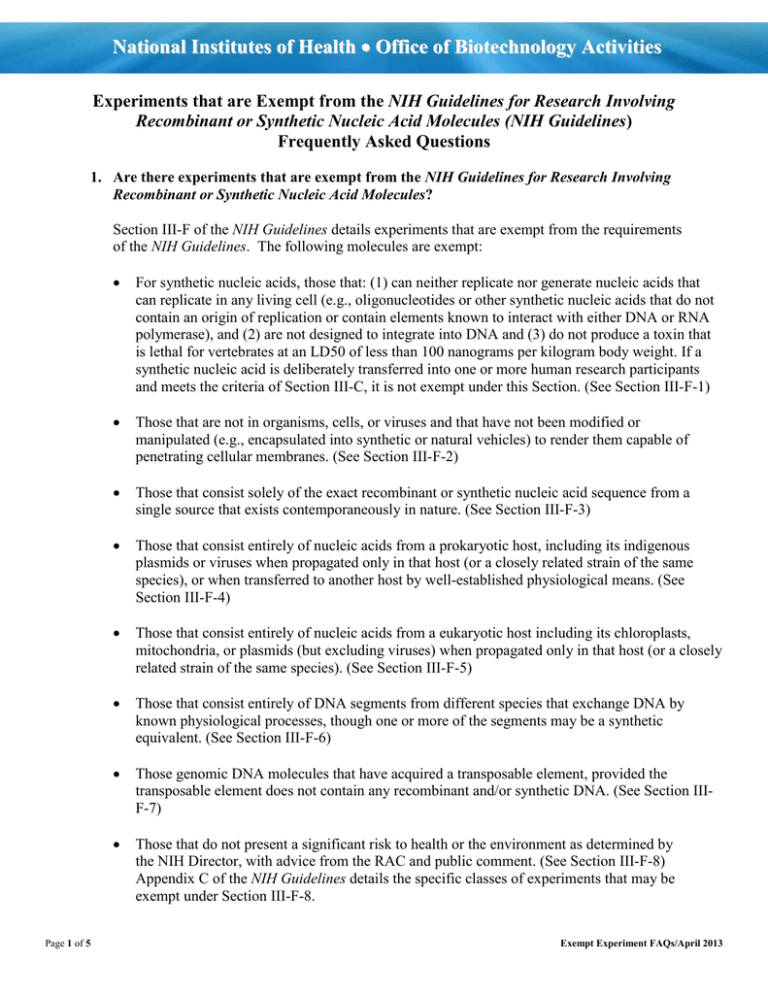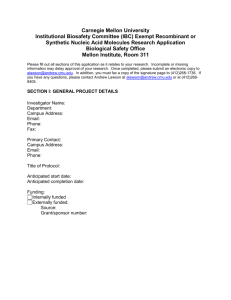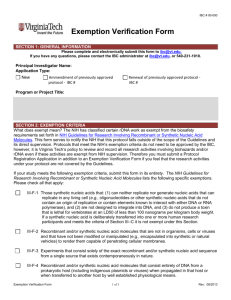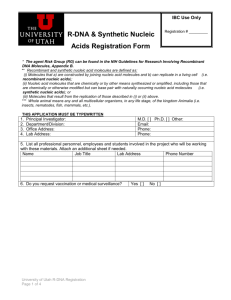N a t
advertisement

National Institutes of Health Office of Biotechnology Activities Experiments that are Exempt from the NIH Guidelines for Research Involving Recombinant or Synthetic Nucleic Acid Molecules (NIH Guidelines) Frequently Asked Questions 1. Are there experiments that are exempt from the NIH Guidelines for Research Involving Recombinant or Synthetic Nucleic Acid Molecules? Section III-F of the NIH Guidelines details experiments that are exempt from the requirements of the NIH Guidelines. The following molecules are exempt: For synthetic nucleic acids, those that: (1) can neither replicate nor generate nucleic acids that can replicate in any living cell (e.g., oligonucleotides or other synthetic nucleic acids that do not contain an origin of replication or contain elements known to interact with either DNA or RNA polymerase), and (2) are not designed to integrate into DNA and (3) do not produce a toxin that is lethal for vertebrates at an LD50 of less than 100 nanograms per kilogram body weight. If a synthetic nucleic acid is deliberately transferred into one or more human research participants and meets the criteria of Section III-C, it is not exempt under this Section. (See Section III-F-1) Those that are not in organisms, cells, or viruses and that have not been modified or manipulated (e.g., encapsulated into synthetic or natural vehicles) to render them capable of penetrating cellular membranes. (See Section III-F-2) Those that consist solely of the exact recombinant or synthetic nucleic acid sequence from a single source that exists contemporaneously in nature. (See Section III-F-3) Those that consist entirely of nucleic acids from a prokaryotic host, including its indigenous plasmids or viruses when propagated only in that host (or a closely related strain of the same species), or when transferred to another host by well-established physiological means. (See Section III-F-4) Those that consist entirely of nucleic acids from a eukaryotic host including its chloroplasts, mitochondria, or plasmids (but excluding viruses) when propagated only in that host (or a closely related strain of the same species). (See Section III-F-5) Those that consist entirely of DNA segments from different species that exchange DNA by known physiological processes, though one or more of the segments may be a synthetic equivalent. (See Section III-F-6) Those genomic DNA molecules that have acquired a transposable element, provided the transposable element does not contain any recombinant and/or synthetic DNA. (See Section IIIF-7) Those that do not present a significant risk to health or the environment as determined by the NIH Director, with advice from the RAC and public comment. (See Section III-F-8) Appendix C of the NIH Guidelines details the specific classes of experiments that may be exempt under Section III-F-8. Page 1 of 5 Exempt Experiment FAQs/April 2013 National Institutes of Health Office of Biotechnology Activities 2. Are the experiments described in Section III-F and Appendix C of the NIH Guidelines always exempt, or are there circumstances in which the research might require IBC review and approval under NIH Guidelines? If an experiment falls under Sections III-A, III-B, or III-C and also III-F, then the research is not exempt (see the note Under Section III of the NIH Guidelines). The three types of experiments that would not be exempt under this provision are: The deliberate transfer of a drug resistance trait to microorganisms that are not known to acquire the trait naturally, if such acquisition could compromise the use of the drug to control disease agents in humans, veterinary medicine or agriculture [Section III-A]; Deliberate formation of recombinant or synthetic nucleic acid molecules containing genes for the biosynthesis of toxin molecules lethal for vertebrates at an LD50 of less than 100 nanograms per kilogram body weight (e.g., microbial toxins such as the botulinum toxins, tetanus toxin, diphtheria toxin, and Shigella dysenteriae neurotoxin). [Section III-B]; or The deliberate transfer into human research participants of either: o Recombinant nucleic acid molecules, or DNA or RNA derived from recombinant nucleic acid molecules, or o Synthetic nucleic acid molecules, or DNA or RNA derived from synthetic nucleic acid molecules, that meet any one of the following criteria: Contain more than 100 nucleotides; or Possess biological properties that enable integration into the genome (e.g., cis elements involved in integration); or Have the potential to replicate in a cell; or Can be translated or transcribed. [Section III-C]. In addition, there are certain exceptions to the exemptions described in Appendix C of the NIH Guidelines. [See Appendix C-1-A, through C-V1-A]. In addition to the three types of experiments listed above, these exceptions include experiments involving: Page 2 of 5 DNA from Risk Group 3, 4, or restricted organisms or cells known to be infected with these agents Whole plants regenerated from plant cells and tissues cultures that do not remain axenic cultures Large scale experiments (more than 10 liters of volume in a single culture vessel) Deliberate introduction of genes coding for the biosynthesis of molecules that are toxic for vertebrates with an LD50 greater than 100 nanograms/kg but less than or equal to 100 micrograms/kg (see Appendix F) Exempt Experiment FAQs/April 2013 National Institutes of Health Office of Biotechnology Activities 3. The NIH Guidelines exempt certain experiments that do not pose a threat to health or the environment. Can an Institutional Biosafety Committee (IBC) or Principal Investigator (PI) determine if an experiment does not pose such a threat and is therefore exempt? Section III-F-8 of the NIH Guidelines refers to categories of experiments that the NIH Director has determined do not present a significant risk to health or the environment and are therefore exempt. This determination was made with the advice of the RAC, following appropriate notice and opportunity for public comment. PIs and IBCs cannot make the determination that a class of experiments other than the ones listed below poses no significant risk. The following classes of experiments are exempt under Section III-F-8: Certain recombinant or synthetic nucleic acid molecules that contain less than one-half of any eukaryotic viral genome when propagated and maintained in cells in tissue culture [Appendix C-I – see question 8 below for more information on the limits of this exemption] Escherichia coli K-12 host-vector systems [Appendix C-II] Saccharomyces cerevisiae or Saccharomyces uvarum host-vector systems [Appendix C-III] Kluyveromyces lactis host-vector Systems [Appendix C-IV] Bacillus subtilis or Bacillus licheniformis host-vector systems [Appendix C-V] Extrachromosomal elements of gram positive organisms [see specific list of organisms in Appendix C-VI] The purchase or transfer of transgenic rodents [Appendix C-VII] Generation of certain BL1 Transgenic Rodents via Breeding [Appendix C-VIII] A full description of the exemptions with exceptions can be found in Appendix C of the NIH Guidelines. 4. How do I know if I am working with host-vector system that is exempt from the NIH Guidelines? Only certain experiments that use E. coli K-12, Saccharomyces cerevisiae or Saccharomyces uvarum, Kluyveromyces lactis, Bacillus subtilis or Bacillus licheniformis host-vector systems are exempt from the NIH Guidelines (see Appendix C). If you are obtaining an E. coli hostvector system from a commercial supplier, genotype information may be available to permit determination of the strain from which the host is derived. 5. Nucleic acid molecules resulting from the replication of recombinant or synthetic nucleic acids are subject to the NIH Guidelines. Are any other materials derived from or produced by genetically engineered organisms subject to the requirements of the NIH Guidelines? No. For example, proteins produced by genetically engineered organisms are not subject to the NIH Guidelines. Page 3 of 5 Exempt Experiment FAQs/April 2013 National Institutes of Health Office of Biotechnology Activities 6. Are any types of human gene transfer trials exempt from the requirements of the NIH Guidelines? If the investigational product meets the criteria described in Section III-C of the NIH Guidelines and involves the deliberate transfer of recombinant or synthetic nucleic acid molecules, or DNA or RNA derived from recombinant or synthetic nucleic acid molecules, into one or more human research participants, then the research will be subject to the NIH Guidelines. Synthetic nucleic acid molecules that contain less than 100 nucleotides, or do not possess biological properties that enable integration into the genome (e.g., cis elements involved in integration); or do not have the potential to replicate in a cell; or do not have the potential to be translated or transcribed are not covered under Section III-C. In addition, Appendix M-VI-A of the NIH Guidelines exempts certain types of vaccine trials from the requirements for submission of the protocol to NIH OBA, RAC review, and subsequent reporting (Appendix M-I). Specifically, this exemption applies to "human studies in which induction or enhancement of an immune response to a vector-encoded microbial immunogen is the major goal, such an immune response has been demonstrated in model systems, and the persistence of the vector-encoded immunogen is not expected." Trials with these characteristics do not have to be registered with NIH OBA or undergo RAC review, but can be submitted on a voluntary basis, particularly if the investigator believes that a trial presents scientific, safety, or ethical concerns that would benefit from RAC review and public discussion. Investigators that submit trials voluntarily will be expected to comply with all aspects of the protocol review and reporting requirements. OBA encourages investigators and institutional review bodies to contact us (oba@od.nih.gov) for assistance in determining whether this exemption applies to a particular trial. It is important to note that Appendix M-VI-A does not exempt these vaccine trials from other requirements specified in the NIH Guidelines, including biosafety review. Thus, vaccine trials, like other human gene transfer trials subject to the NIH Guidelines, must be reviewed and approved by an IBC before research participants can be enrolled. For further information see the FAQ on experiments that are exempt from the NIH Guidelines at: http://oba.od.nih.gov/rdna/rdna_faq_list.html 7. There is a note at the beginning of Section III of the NIH Guidelines that states “If an experiment falls into Section III-F and into either Sections III-D or III-E as well, the experiment is considered exempt from the NIH Guidelines.” What is meant by this note? If an experiment falls into Section III-D or III-E of the NIH Guidelines and also falls into section III-F, it is exempt. An example of such an experiment is the following: Staphylococcus aureus (a Risk Group 2 bacterium) contains a recombinant plasmid. The plasmid is indigenous to S. aureus, was created in vitro, and contains only DNA from S. aureus (i.e., the DNA inserted into the plasmid was S. aureus DNA). Rationale: The introduction of recombinant DNA into Risk Group 2 agents is usually covered Page 4 of 5 Exempt Experiment FAQs/April 2013 National Institutes of Health Office of Biotechnology Activities under Section III-D-1-a. However, because the experiments are only performed in S. aureus, this work would fall under III-F-4 (experiments that consists entirely of DNA from a prokaryotic host including its indigenous plasmids when propagated only in that host or a closely related strain of the same species). Thus this experiment falls into both Sections III-D and III-F and is exempt, due to the above note, from the requirements of the NIH Guidelines for IBC review and approval. It should be noted that only experiments covered by both III-D or III-E and III-F are considered to be exempt. If an experiment falls into Section III-A, III-B or III-C and any one of the other sections, then the rules pertaining to Sections III-A, III-B or III-C must be followed. 8. Appendix C-1 of the NIH Guidelines exempts experiments involving recombinant or synthetic nucleic acid molecules in tissue culture. I have a cell line that was created by the introduction of recombinant DNA. Are all experiments that I conduct with this cell line exempt from the requirements of the NIH Guidelines? No. Although Appendix C-1 does exempt the use of recombinant or synthetic nucleic acid molecules in tissue culture, there are exceptions to this exemption. Existing tissue culture cell lines created by the introduction of recombinant or synthetic nucleic acid molecules are exempt from the NIH Guidelines unless, the cell line: was modified using DNA from Risk Group 3 or 4 agents, or from restricted agents [Section III-D]; contains a toxin with an LD50 of less than 100 nanograms per kilogram/kg body weight [Section III-B-1]; contains viral DNA in a quantity exceeding 50% of any viral genome [Appendix C-I]; is used in conjunction with defective viruses in the presence of helper virus [Section III-D3]; is used in an experiment involving the deliberate transfer of the cell line into humans [Section III-C-1]; or is grown in a volume exceeding 10 liters of culture [Section III-D-6]. Page 5 of 5 Exempt Experiment FAQs/April 2013





